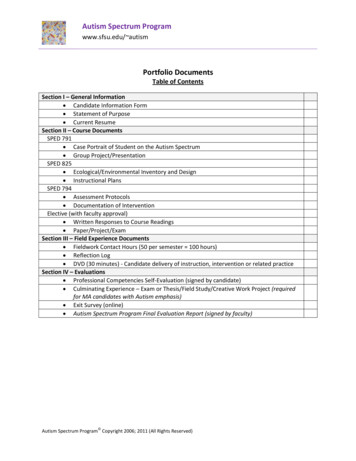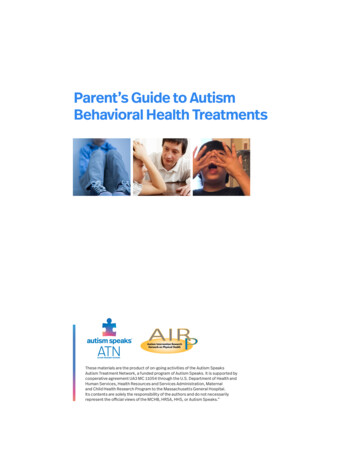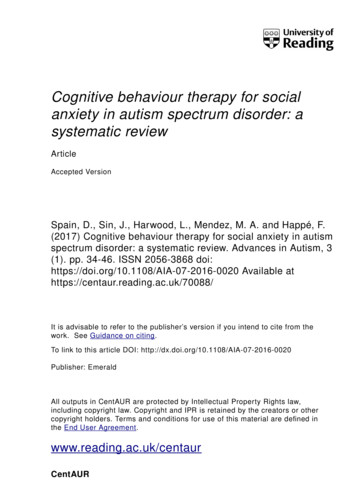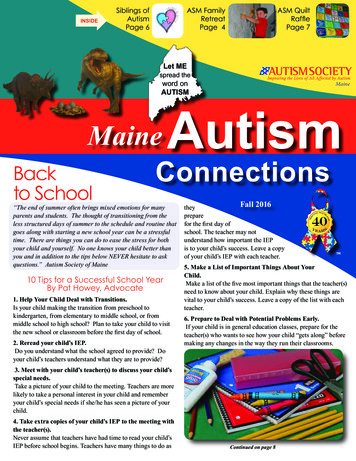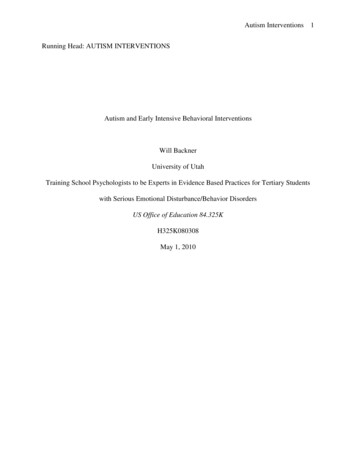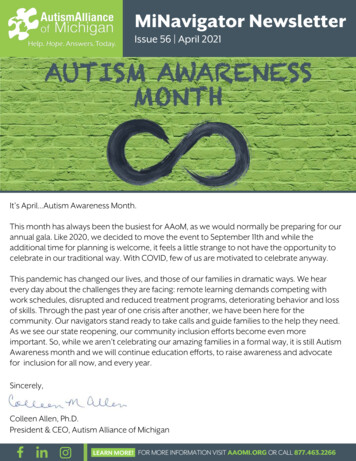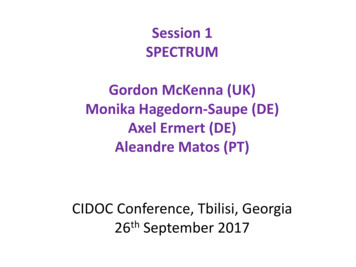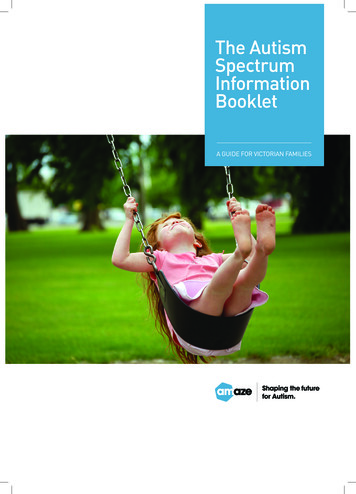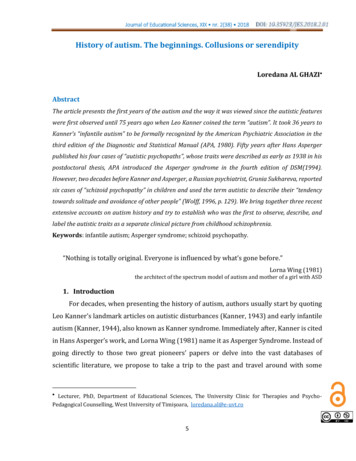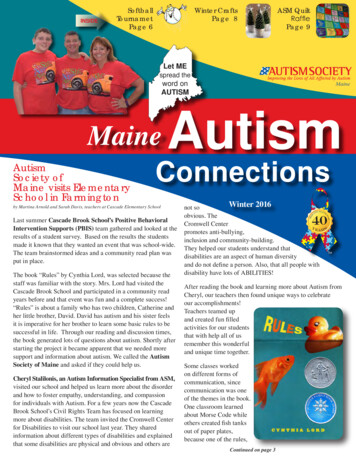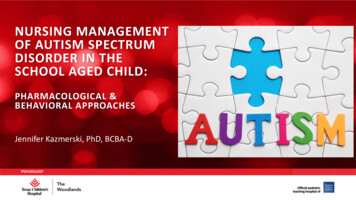
Transcription
NURSING MANAGEMENTOF AUTISM SPECTRUMDISORDER IN THESCHOOL AGED CHILD:PHARMACOLOGICAL &BEHAVIORAL APPROACHESJennifer Kazmerski, PhD, BCBA-DPSYCHOLOGY
41st Annual Belle Blackwell School Nurse ConferenceProvided by Texas Children’s HospitalProvider #18-267764-A7.24.2019 Cypress, TX 7a – 5:30pCONTINUING NURSING EDUCATIONTexas Children's Hospital is an approved provider with commendation of continuing nursing education by the Texas Nurses Association - Approver,an accredited approver with distinction, by the American Nurses Credentialing Center’s Commission on Accreditation.REQUIREMENTS FOR SUCCESSFUL COMPLETIONTo receive contact hours for this continuing education activity, the participant must: Sign in to the activity Attend the entire activity Complete a participant evaluation onlineOnce successful completion has been verified, a “Certificate of Successful Completion” will be awarded for 6.0 contact hour(s). For web link issues,email cne@texaschildrens.orgLEARNING OUTCOMEAt the conclusion of this continuing nursing education activity, the participant will be able to improve nursing management, care coordination andresources for school age children.CONFLICTS OF INTERESTExplanation: A conflict of interest occurs when an individual has an opportunity to affect or impact educational content with which he or she mayhave a commercial interest or a potentially biasing relationship of a financial nature. All planners and presenters/authors/content reviewers mustdisclose the presence or absence of a conflict of interest relative to this activity. All potential conflicts are resolved prior to the planning,implementation, or evaluation of the continuing nursing education activity. All activity planning committee members andpresenters/authors/content reviewers have submitted Conflict of Interest Disclosure forms.The activity’s Nurse Planner has determined that no one who has the ability to control the content of this CNE activity – planning committeemembers and presenters/authors/content reviewers – has a conflict of interest.COMMERCIAL SUPPORTThis CNE activity has not received commercial support.JOINT PROVIDER STATEMENTThis CME/CNE activity has been jointly provided by Texas Children’s Hospital collaboratively with Texas School Nurses Organization Region IV.
NURSING MANAGEMENT OF AUTISM SPECTRUM DISORDER IN THE SCHOOL AGED CHILDOverview:Objectives:INTRODUCTION:A. What is autism?B. How common is IT?C. What causes autism?1. Develop a better understanding of whatautism spectrum disorder is (and is not), andwhat features are considered “core” to thisdisorder.DIAGNOSISMANAGEMENT/TREATMENTA. Behavioral (ABA)B. Medications used for comorbiditiesHOW YOU CAN HELPQ&APSYCHOLOGY2. Understand how autism spectrum disorderis diagnosed and treated.3. Recognize the many ways you, and otherswithin the community, can get involved andhelp support children and families who havebeen affected by autism spectrum disorder.
WHAT IS AUTISM? Neurodevelopmental disorder that affects a person’s socialcommunication and behavioral domains Developmental in onset, conceptualized as lifelong A “spectrum” of different symptoms and severity levelsPSYCHOLOGY
PSYCHOLOGY
DSM-5 CRITERIA FOR AUTISM SPECTRUM DISORDERA. Social Communication and Interaction (Must have 3 of 3)1.2.3.Deficits in social-emotional reciprocityDeficits in nonverbal communicative behaviors used for social interactionDeficits in developing, maintaining, and understanding social relationshipsB. Restricted, repetitive patterns of behavior, interests, and activities(Must have 2 of 4)1.2.3.4.PSYCHOLOGYStereotyped or repetitive motor movements, use of objects, or speechInsistence on sameness, inflexible adherence to routines, or ritualized patterns of verbal ornonverbal behaviorHighly restricted, fixated interests that are abnormal in intensity or focusHyper- or hyporeactivity to sensory input or unusual interest in sensory aspects of theenvironment
SOCIAL COMMUNICATION CRITERIA(MUST HAVE 3/3)1.Deficits in social-emotional reciprocity,ranging from abnormal social approach and failureof normal back-and-forthconversation; to reduced sharing of interests,emotions, or affect; to failure to initiate or respond to socialinteractionsPSYCHOLOGY
SOCIAL COMMUNICATION CRITERIA(MUST HAVE 3/3)2.Deficits in nonverbal communicative behaviorsused for social interaction, ranging from Poorly regulated integrated verbal and nonverbalcommunication; to abnormalities in eye contact and body language ordeficits in understanding and use of gestures; to Total lack of facial expressions and nonverbalcommunicationPSYCHOLOGY
SOCIAL COMMUNICATION CRITERIA(MUST HAVE 3/3)3. Deficits in developing, maintaining, andunderstanding social relationships, rangingfrom Difficulties adjusting behavior to suit varioussocial contexts; to Difficulties in sharing imaginative play or inmaking friends; to Absence of interest in peersPSYCHOLOGY
RESTRICTED/REPETITIVE BEHAVIOR CRITERIA(MUST HAVE 2/4)1. Stereotyped or repetitive motor movements, use of objects,or speech, such as Simple motor stereotypies Lining up toys Flipping objects Echolalia Idiosyncratic phrasesPSYCHOLOGY
RESTRICTED/REPETITIVE BEHAVIOR CRITERIA(MUST HAVE 2/4)2. Insistence on sameness, inflexible adherence to routines, orritualized patterns of verbal or nonverbal behavior, such as Extreme distress at small changes Difficulties with transitions Rigid thinking patterns Greeting rituals Need to take same route or eat same food every dayPSYCHOLOGY
RESTRICTED/REPETITIVE BEHAVIOR CRITERIA(MUST HAVE 2/4)3. Highly restricted, fixated interests that are abnormal inintensity or focus, such as Strong attachment to or preoccupation with unusual objects Excessively circumscribed or perseverative interestsPSYCHOLOGY
RESTRICTED/REPETITIVE BEHAVIOR CRITERIA(MUST HAVE 2/4)4. Hyper- or hyporeactivity to sensory input or unusual interestin sensory aspects of the environment, such as Apparent indifference to pain/temperature Adverse response to specific sounds or textures Excessive smelling or touching of objects Visual fascination with lights or movementPSYCHOLOGY
PSYCHOLOGY
COMMON COMORBIDITIES Intellectual Disability ADHD Anxiety Disorders Mood Disorders Sleep Disorders GI Disorders Seizures & TicsPSYCHOLOGY
HOW PREVALENT IS ASD?Identified Prevalence of Autism Spectrum Disorder:ADDM Network 2000-2014 Combining Data from All SitesPSYCHOLOGY
FACTORS THAT IMPACT ASD PREVALENCE Increases in Awareness & access to services Identification of toddlers Identification of children with average/above average intelligence Changes in Diagnostic criteria & substitution Study methodologyPSYCHOLOGY
WHAT CAUSES AUTISM? Many pathways, most not yet well defined or understood Small percentages of children with ASD have a genetic orchromosomal disorder of known significance (10-20%) Other biological / environmental factors under investigation;few effects are well-established, and none account for largepercentages of the ASD populationPSYCHOLOGY
ASD RISK FACTORS Males are 4-5 times more likely to have ASD than females Family risk factors Parents who have a child with ASD have a 2%–18% chance of having a second child who is also affected. 20-40% of siblings of a child with autism have language and/or social deficits. Children born to older parents are at a higher risk for having ASD. Twin studies 36-95% of identical (monozygotic) twin pairs0-31% of non-identical (dizygotic) twin pairs A small percentage of children who are born prematurely or with low birth weight are at greater risk for having ASD. ASD commonly co-occurs with other developmental, psychiatric, neurologic, chromosomal, and genetic diagnoses. The co-occurrence of one or more non-ASD developmental diagnoses is 83%. The co-occurrence of one or more psychiatric diagnoses is 10%. Almost half (44%) of children identified with ASD has average to above average intellectual ability.www.cdc.govPSYCHOLOGY
WHAT ABOUT VACCINES?2001 – FDA: “No evidence of harm from the use of thimerosal”2003 – AAP: “No scientific data link thimerosal with any pediatric neurologic disorder, including autism.”2004 – IOM: Scientific review favors rejection of the hypothesized causal links between MMR/thimerosal vaccines andautism2010 - Lancet retracts original 1998 paper suggesting vaccines may cause autism due to “deception and ethics violations”2011 – CDC: “No convincing scientific evidence of harm"2014 – Pediatrics publishes systematic review describing “strong evidence that MMR vaccine is not associated with autism”2015 – JAMA publishes large cohort study identifying “no harmful association between MMR vaccine receipt and ASD”PSYCHOLOGY
DIAGNOSIS The first step in diagnosis is early detection, typically by routinedevelopmental screening provided at routine well child checks. All children should be screened for developmental delays anddisabilities at: 9 months18 months24 or 30 monthsIn addition, all children should be screened specifically for ASD at: PSYCHOLOGY18 months24 or 30 months
PSYCHOLOGYhttp://firstwords.fsu.edu/
MODIFIED CHECKLIST FOR AUTISM IN TODDLERS M-CHAT Revised with Follow-Up (2014) Ages 16-30 months Multiple languages Free 20 Yes/No items follow-up interviewPSYCHOLOGY
DIAGNOSIS The second step of diagnosis is a comprehensive evaluation which typically includes:1. Parent and collateral interviews to assess developmental course, social history, and current behavioral concerns2. Formal evaluation of: Cognitive / developmental abilities Speech and language abilities Adaptive and social functioning Fine/gross motor and sensory functioning3. Direct observation- May also include a hearing and vision screening, genetic testing and other medical diagnostic studiesPSYCHOLOGY
Autism Diagnostic Observation Schedule (ADOS-2)Gold standard to support diagnosis in clinical and research contextsPSYCHOLOGY
TREATMENT OPTIONS BEHAVIORAL: Applied Behavior Analysis (ABA) PHARMACOLOGIC : Aggression Anxiety Attention Deficit Hyperactivity DisorderPSYCHOLOGY
APPLIED BEHAVIOR ANALYSIS Applied Behavior Analysis The science of how learning and behavior changetakes place “ABA Therapy” often refers to intense, structured one-on-one teaching based on the principles of applied behavioranalysisBehavioral intervention may also be called: Early intensive behavioral intervention (EIBI) Operant conditioning Positive behavioral supports Classroom behavior management Behavior modification Behavior therapy Behavioral parent training (e.g., PCIT)PSYCHOLOGY
APPLIED BEHAVIOR ANALYSIS Numerous modalities, including: Discrete trial teachingPECS / FCTIncidental / Naturalistic teachingPivotal response trainingVerbal behaviorEarly Start Denver ModelParent-mediated interventions (emerging support)Best outcomes occur when: Children receive 25 hours/wk between ages 2-5 Functional communication established by age 5Intervention targets “learning to learn” skillsIntervention includes planning for generalization – expanding beyond 1-on-1 PSYCHOLOGYIncludes behaviorally based special education, speech therapies, etc.
DISCRETE TRIAL TEACHING Key elements Massed repetition &practice of very specificbehaviors & skills Gradual increases indifficulty Targeted encouragementof skills using highpreferred rewardsPSYCHOLOGY
FUNCTIONAL COMMUNICATION TRAINING Goal: Improve expressive language skillsthrough repetition and practice Modality tailored to child Verbal language Picture exchanges (e.g., PECS) Sign language Augmentative communication device (e.g., iPad)PSYCHOLOGY
VISUAL SUPPORTSPSYCHOLOGY
NATURALISTIC/INCIDENTAL TEACHING Goal: Use child motivation and teaching opportunities in thenatural environment to build behavioral, communication andadaptive skillsPSYCHOLOGY
SPEECH/LANGUAGE THERAPY Intensive, behaviorally-based structured teaching Augmentative strategies Sign language PECS Electronic devices Increase functional language Developmental/social pragmatics Effective use of verbal and nonverbal communication strategies toimprove social interaction (i.e., social skills training)PSYCHOLOGY
PHYSICAL & OCCUPATIONAL THERAPIES OTFine motor coordinationAdaptive skills Sensory Integration– Addresses “sensory abnormalities”– No evidence of correspondingneurological changes**Inconsistent evidence of effects oncore ASD symptoms or behavior**PSYCHOLOGY PTBalance & coordinationdifficultiesNatural environment– Adaptive PE, communityactivities, hippotherapy, etc.
35ESTABLISHED TREATMENTSlPSYCHOLOGYBehavioral Interventionsl Emphasizes Antecedent and Consequence Interventionsl 155 studies17 in adults
TREATMENTS WITH EMERGING EFFECTIVENESS(BEING FURTHER STUDIED)llllllllAugmentative and AlternativeCommunication DevicesDevelopmental Relationship-based TreatmentExerciseExposure PackageFunctional Communication TrainingImitation Based InteractionInitiation TrainingLanguage llllMassage TherapyMusic TherapyPicture Exchange CommunicationReductive PackageSign InstructionSocial Communication InterventionStructured TeachingTechnology-Based TrainingTheory of Mind TrainingVocational Training Package (for adults)Always start by trying an established treatment before movingto these less studied interventions
UNESTABLISHED AND POSSIBLY INEFFECTIVE/HARMFUL INTERVENTIONSFor under 22 Animal assisted TherapyAuditory Integration TrainingConcept MappingDIR/Floor TimeFacilitated CommunicationGluten & Casein Free DietsMovement-Based InterventionSENSE Theatre InterventionSensory Integration PackageShock TherapySocial Behavior Learning StrategySocial Cognition InterventionSocial Thinking InterventionPSYCHOLOGYFor Adults Cognitive BehavioralIntervention Package Modeling Music Therapy Sensory IntegrationPackage
38Skills IncreasedSUMMARY OF ALL EFFECTIVE INTERVENTIONS FOR SPECIFIC AREASBehaviors DecreasedPSYCHOLOGY
PSYCHOPHARMACOLOGY Adjunct to educational,developmental & behavioraltreatments Focused on treating associated(rather than core) ASDsymptoms Evidence supporting is variablePSYCHOLOGY Targeted tention spanSelf-injurious behaviorAggressionSleepOwen et al. (2009)McDougle et al. (2005)Fung et al. (2016)
PHARMACOLOGIC Aggression: The Journal of Autism and Developmental Disorders has published a new studyshowing that nearly 28% of 8-year-old children with autism spectrum disorder(ASD) behave in ways that can lead to self-injury. Tx: Antipsychotics (Risperdone, Abilify) Anxiety: SSRIs, SNRIs Attention Deficit Hyperactivity Disorder Stimulants or nonstimulantsPSYCHOLOGY
COMPLEMENTARY & ALTERNATIVE TREATMENTS ChelationHyperbaric Oxygen TherapyVitamins/SupplementsImmune & Hormone TherapiesAuditory, Visual & Music Therapy Biologically BasedMind-body Medicine– Yoga– Music TherapyManipulative and Body-based– Chiropractic– Massage/Therapeutic Touch– Auditory IntegrationEnergy Medicine– Transcranial & magnetic stimulation PSYCHOLOGY 30% of patients use some form Most use multiple forms 9% use potentially harmful formsMost commonly used 50% - Biologically based30% - Mind-body25% - Manipulative/body
HOW YOU CAN HELP1. Help DETECT early signsPSYCHOLOGY
HOW YOU CAN HELP2. Be a RESOURCEIncrease your own knowledge & share itwith others: Advise parents of any concerns you noteregarding their child’s development andbehavior Recommend appropriate assessment,referrals/interventions Distribute patient/parents resourcesPSYCHOLOGY
SAFETY PLANNINGDid you know? Children with ASD are 8 times more likely toelope between the ages of 7 and 10 than theirtypically developing siblings From 2009-2011, accidental drowning (duringwandering/elopement) accounted for 91% ofdeaths for children with ASD under age 15 in theUS Half of families with elopers never receiveguidance about elopement from a professional Only 14% receive guidance from a physicianPSYCHOLOGY12 Ways to Prevent erstand and EliminateTeach SafetySecure Your HomeConsider Personal LocatorConsider ID MaterialsSwimming LessonsAlert NeighborsAlert First RespondersInitiate “TAG” SystemSecure External SettingsLearn From othersNever Have False Sense
HOW YOU CAN HELP3. GET INVOLVEDPSYCHOLOGY
BIGGEST TAKE-HOME POINTS Active screening and responsiveness of all of a child’s caregivers has amajor impact on identifying children early Early intensive behavioral intervention (i.e., “ABA” or applied behavioranalysis) can profoundly shift the outcomes of children with autismspectrum disorders Medical, developmental, behavioral, safety, and family/social risk factorsmust be monitored & addressed by providers and the communityPSYCHOLOGY
RESOURCES autismspeaks.org– Toolkits: First 100 Days, ChallengingBehaviors, Sleep, Feeding, needle sticks,etc. m-chat.org/ nationalautismassociation.org& autismsafety.org– Safety resourcesPSYCHOLOGY
SELECTED REFERENCES Whitehouse & Stanley erican Psychiatric Association. (2013). Diagnostic and statisticalmanual of mental disorders, (DSM-5 ). American Psychiatric Pub.Baio, J., Wiggins, L, Christensen, D. L., Maenner, M. J., Daniels, J.,Warren, Z., . . . Dowling, N. F. (2018). Prevalence of Autism SpectrumDisorder Among Children Aged 8 Years. Autism and DevelopmentalDisabilities Monitoring Network, 11 Sites, United States, 2014.Surveillance Summaries / April 27, 2018 / 67(6);1–23 Retrieved 1.htmGabrielsen TP, Farley M, Speer L, Villalobos M, Baker CN, Miller J.Identifying autism in a brief observation. Pediatrics 2015; 135:e330-8.Heil, K. M., & Schaaf, C. P. (2013). The genetics of autism spectrumdisorders–a guide for clinicians. Current psychiatry reports, 15(1), 1-8.Hill, A. P., Zuckerman, K. E., & Fombonne, E. (2014). Epidemiology ofAutism Spectrum Disorders. Handbook of Autism and PervasiveDevelopmental Disorders, Fourth Edition.Lord, C., Petkova, E., Hus, V., Gan, W., Lu, F., Martin, D. M., et al. (2012).A multisite study of the clinical diagnosis of different autism spectrumdisorders. Archives of General Psychiatry, 69(3), 306–313.Mannion, A., & Leader, G. (2013). Comorbidity in autism spectrumdisorder: A literature review. Research in Autism SpectrumDisorders, 7(12), 1595-1616.PSYCHOLOGY ardsproject/Ozonoff, S., Goodlin-Jones, B. L., & Solomon, M. (2005). Evidencebased assessment of autism spectrum disorders in children andadolescents. Journal of Clinical Child and AdolescentPsychology, 34(3), 523-540.Robins et al. (2014). Validation of the M-CHAT-R/F. Pediatrics.Rogers, S. J., & Vismara, L. A. (2008). Evidence-basedcomprehensive treatments for early autism. Journal of ClinicalChild & Adolescent Psychology,37(1), 8-38.Shelton, J. F., Tancredi, D. J., & Hertz-Picciotto, I. (2010).Independent and dependent contributions of advanced maternaland paternal ages to autism risk. Autism Research, 3(1), 30-39.Zuckerman KE, Lindly OJ, Sinche BK. (2015). Parental concerns,provider response, and timeliness of autism spectrum disorder. JPediatr. doi: 10.1016/j.jpeds.2015.03.007.
PSYCHOLOGY
COMMENTS/QUESTIONS?PSYCHOLOGY
PSYCHOLOGY 2001 - FDA: "No evidence of harm from the use of thimerosal" 2003 - AAP: "No scientific data link thimerosal with any pediatric neurologic disorder, including autism." 2004 - IOM: Scientific review favors rejection of the hypothesized causal links between MMR/thimerosal vaccines and autism 2010 - Lancetretracts original 1998 paper suggesting vaccines may cause autism .
